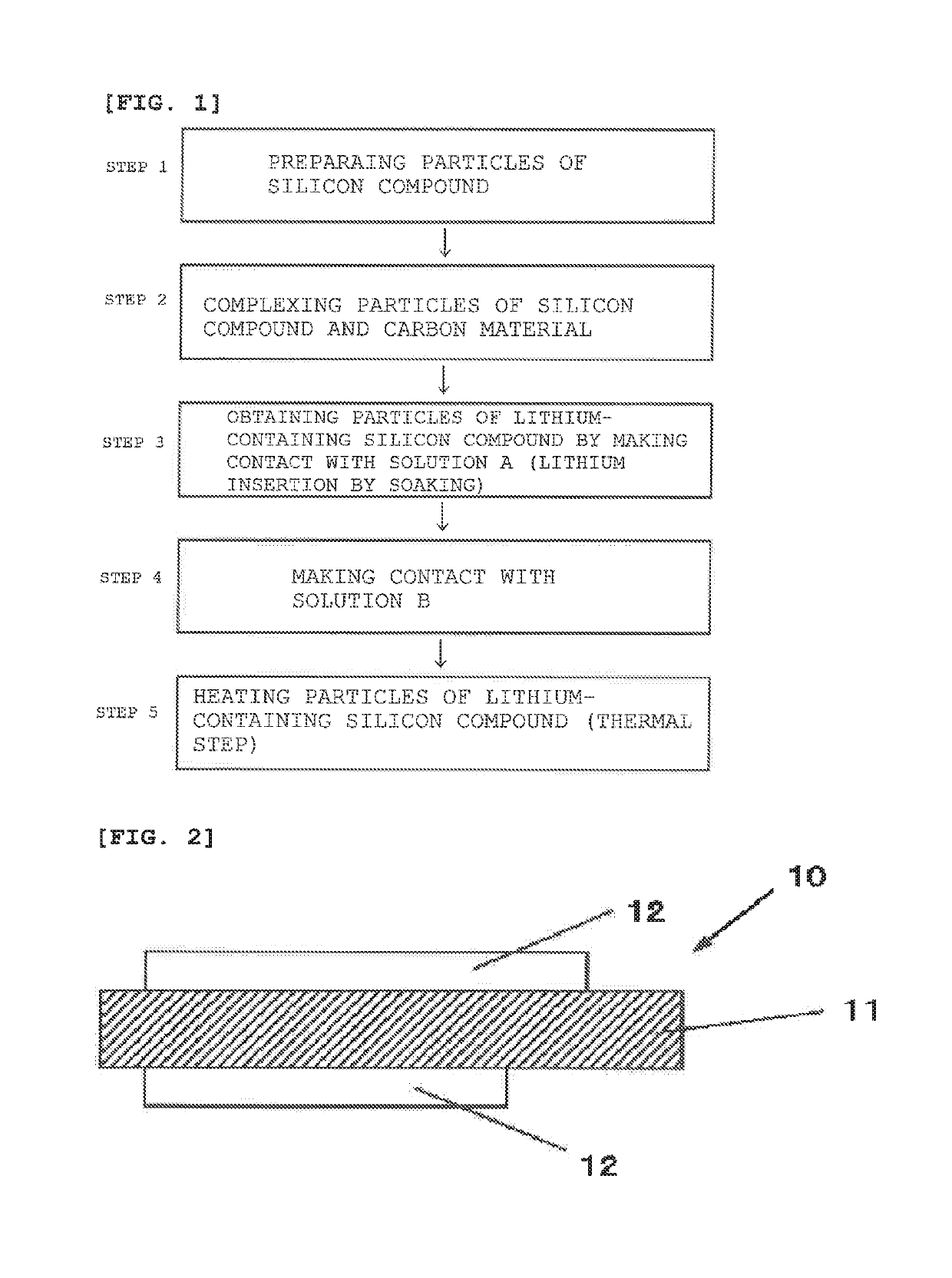Production method of negative electrode active material for non-aqueous electrolyte secondary battery and production method of negative electrode for non-aqueous electrolyte secondary battery
- Summary
- Abstract
- Description
- Claims
- Application Information
AI Technical Summary
Benefits of technology
Problems solved by technology
Method used
Image
Examples
example 1-1
[0187]At first, a silicon-based active material was prepared as shown below.
[0188]First, a raw material (a vaporization starting material) obtained by mixing metallic silicon and silicon dioxide was set in a reaction furnace, was vaporized in an atmosphere of a vacuum of 10 Pa and deposited on an absorption plate, and, after sufficiently cooling, a deposit (SiOx: x=0.5) was taken out and pulverized by a jet mill. After that, the thermal CVD with methane gas was performed to coat a carbon coating film on a surface of particles of a silicon compound.
[0189]By the way, as shown also in the following Table 1, in the particles of silicon compound after the generation of a carbon coating film, a crystallite size of silicon calculated from a half value width of a diffraction peak due to a Si(111) crystal plane obtained from X-ray diffractometry was 3.77 nm. Furthermore, a coating amount of carbon was 5% by mass relative to the particles of silicon compound.
[0190]Subsequently, the particles ...
examples 1-2 to 1-5
, Comparative Examples 1-1 and 1-2
[0206]Each negative electrode active material (silicon-based active material) was prepared in the same manner as in Example 1-1 except that x in the SiOx was varied. And, the battery characteristics were evaluated in the same manner as in Example 1-1.
[0207]When the first time charge / discharge characteristics of the test cells (coin batteries) and the capacity retention rate of the laminate film-type secondary batteries, which were prepared in Examples 1-1 to 1-5 and Comparative Examples 1-1 and 1-2 are investigated, results shown in Table 1 were obtained. By the way, the first time discharge capacity of Example 1-3 was 1360 mAh / g. By the way, in Tables 1 to 5, the Li insertion by soaking and the contacting with the solution B (deactivation of oxidant) are described by summarizing as a Li solution method.
TABLE 1Si (111) crystallite 3.77 nm, coating amount of carbon: 5%by mass, process Li solution method (Li insertion / oxidantdeactivation)→heating meth...
example 2-1
, Comparative Examples 2-1 to 2-5
[0209]Each negative electrode active material was prepared in the same manner as in Example 1-3 except that presence or absence of the contacting with the solution B, presence or absence of the heating, and presence or absence of the carbon coating film of the particles of silicon compound were varied. And, in the same manner as in Example 1-3, the battery characteristics were evaluated. In Comparative Example 2-1, the Li insertion, the contacting with the solution B and the heating (heating method) were not applied. In Comparative Example 2-2, after carrying out the Li insertion by contacting and the contacting with the solution B, the heating was not applied. By the way, the contact method of Comparative Example 2-2 is a method of making a Li metal and the Si compound contact. In Comparative Example 2-3, the Li insertion and the contact with the solution B were not applied, only the thermal step was applied. In Comparative Example 2-4, after the Li...
PUM
 Login to View More
Login to View More Abstract
Description
Claims
Application Information
 Login to View More
Login to View More - R&D
- Intellectual Property
- Life Sciences
- Materials
- Tech Scout
- Unparalleled Data Quality
- Higher Quality Content
- 60% Fewer Hallucinations
Browse by: Latest US Patents, China's latest patents, Technical Efficacy Thesaurus, Application Domain, Technology Topic, Popular Technical Reports.
© 2025 PatSnap. All rights reserved.Legal|Privacy policy|Modern Slavery Act Transparency Statement|Sitemap|About US| Contact US: help@patsnap.com


